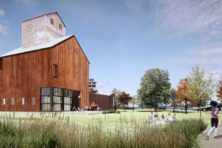Work Beginning Monday on Granary
- Share
- Tweet
- Pin
- Share

The Sturgeon Bay Historical Society Foundation announced that work will begin on Phase II of its rehabilitation of the Teweles and Brandeis Grain Elevator – known as the Door County Granary – on Monday, Feb. 5.
Phase II will restore the interior of the historic structure, complete the exterior, build the catering kitchen and public restroom addition, install landscaping and signage and ready the ground floor for occupancy.
Work on the former grain elevator has been taking place since the historic structure returned to its original site in June 2019 from the east-to-west sides of Sturgeon Bay. Often, that behind-the-scenes work isn’t visible, however – design, engineering, permitting, floodplain review, historic assessment, fundraising – said SBHSF’s Project Manager Nicole Matson.
“Even much of the Phase I work done in 2021 and 2022, like drilling new pilings, pouring a new foundation and restoring the columns that hold up the internal bins, was work the community couldn’t see,” Matson said. “We’re excited to begin a phase of work that will be more visible.”
Construction manager Green Fire Management will oversee the work that includes repairs to the 19 wooden grain bins and other features; construction of the addition; and the installation of siding, windows and doors. Phase II will be completed by the beginning of August.
The Granary is listed on the State and National Registers of Historic Places and was included as a centerpiece in Sturgeon Bay’s West Waterfront Redevelopment Plan in 2019. It also appeared on the cover of Architect Magazine when it won a Progressive Architectural Award in 2021.
Built in 1901 of old-growth timber, the Door County Granary was part of a food pipeline that extended across the United States and allowed grain to be moved from farm fields in western states to markets in the east and even Europe. The Door County Granary is believed to be the last remaining wooden grain elevator located on the Great Lakes.
The Door County Granary will operate as a free, three-season interpreted museum as well as a gathering space for community and private events. “We are now turning our attention to research and museum displays,” said SBHSF president Laurel Hauser. “We will also be fundraising for Phase III, which will allow visitors access to the upper bin and headhouse levels.”
According to Hauser, SBHSF will hire an executive director in the coming months.
“We are grateful to the many donors and volunteers who have supported this project,” Hauser said. “We’re excited to share the Granary’s history, and we can’t wait to invite people into the building.”
SBHSF expects to hold a soft opening in the fall of 2024 and a grand opening in May of 2025 when interpretive elements are installed.Funding for the Door County Granary project has been provided by the USDA Rural Development, the 1923 Fund, the David L. and Rita E. Nelson Family Fund of the Community Foundation of the Fox Valley Region, the National Trust for Historic Places, the Wisconsin Economic Development Corporation and others. Anyone interested in contributing time, expertise, stories, artifacts or funds to the Door County Granary Project should email [email protected] or contact an SBHSF board member. More information is available at sturgeonbayhistoricalsociety.org.


